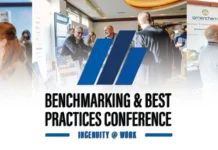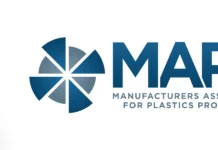The leaders in the plastics processing industry convened in Indianapolis in record numbers for three days in October.
42 Hours of Intense Education and Networking
At the MAPP Benchmarking and Best Practices Conference, nearly 600 attendees gathered with peers, suppliers and expert speakers to discuss the critical issues facing today’s plastics molders.

In what has become a highly anticipated opening, MAPP Executive Director Troy Nix took the stage on the first morning of the conference to reflect on the lessons he has learned through 20 years of association leadership. Nix spoke passionately about how articulating the goals that seem like a stretch – or even an impossibility – can help them come true.
Motivational speaker Connie Podesta had the audience

laughing – and nodding in agreement – as she encouraged conference attendees to understand personality styles and the roles those traits play in decision-making and selling. TV host and explorer Chris “Bash” Bashinelli discussed the power of connecting within a global community. And, world-champion quarterback, broadcaster and entrepreneur Joe Theismann spoke to an attentive audience about the parallels between success on the football field and success in business.
 The power of the MAPP conference, however, isn’t only found in the keynote speakers, no matter how impactful. Sessions led by members of the plastics processing community had the potential to change the way business is done in the facility of each attendee. Organizational leaders in manufacturing companies from across the US shared their successes with apprenticeship programs, employee communication, hiring practices and safety strategies. Industry experts offered insight into succession planning, website analytics, market volatility and manufacturing data.
The power of the MAPP conference, however, isn’t only found in the keynote speakers, no matter how impactful. Sessions led by members of the plastics processing community had the potential to change the way business is done in the facility of each attendee. Organizational leaders in manufacturing companies from across the US shared their successes with apprenticeship programs, employee communication, hiring practices and safety strategies. Industry experts offered insight into succession planning, website analytics, market volatility and manufacturing data.
 Breakfast roundtables on the final day brought together conference attendees in similar job roles to discuss the challenges in their own facilities and ask for feedback from those at the table. Topics included employee accountability for quality standards, hiring and training top talent, smoking and drug use policies, breaking the negative habits of long-term workers and implementing ISO standards.
Breakfast roundtables on the final day brought together conference attendees in similar job roles to discuss the challenges in their own facilities and ask for feedback from those at the table. Topics included employee accountability for quality standards, hiring and training top talent, smoking and drug use policies, breaking the negative habits of long-term workers and implementing ISO standards.
The 2018 MAPP Benchmarking and Best Practices Conference will be held October 10 through 12 in Indianapolis, Indiana.

“In any workplace, employees can be categorized:
- 30% are ‘A’ employees
- 40% are ‘C’ employees
- 30% are ‘F’ employees
Leaders give the work of the ‘F’ employees to the ‘A’ employees – which adds stress to the top members of the staff and gives the nonperformers even less to perform.
Leaders also spent 70 percent of their time and energy with the bottom 30 percent of employees; 25 percent of management-s time is spent with the top 30 percent of employees’ which leaves 5 percent for the employees who need management and leadership the most.
The ‘C’ employees are willing and eager to contribute, but they need training and coaching. Who will provide it?”
– Connie Podesta
 “We did a study that brought home the importance of social relationships within an organization.
“We did a study that brought home the importance of social relationships within an organization.
Traditionally, there’s a vertical-stacked mode of engagement where executives come up with strategy, managers communicate it and employees implement it. But, we found an individual’s engagement is the highest with their peers – people reporting to the same manager.
The manager is responsible for creating the climate – the culture of the team – but, it’s important to understand social connections as they affect employee engagement. Every employee has a role to play in improving the work experience.”
– Sadat Shami, IBM
 “Capacity utilization will never equal profitability! But, selling into open capacity can allow your business to leverage right to the bottom line.”
“Capacity utilization will never equal profitability! But, selling into open capacity can allow your business to leverage right to the bottom line.”
– Laurie Harbour
 “Why implement Industry 4.0?
“Why implement Industry 4.0?
Plastics molders with 4.0 technology have…
- 32% more presses than the average molder operating at 36% higher utilization
- 33% higher sales than the average molder”
– Plante Moran

“In every conversation, there’s the potential for a connection point – a moment – an ‘in.’ At that point, we are no longer trying to get something for ourselves. It’s now about having a relationship and having each other’s back. That’s when we become a community.”
– Chris Bashinelli
 Opportunities to innovate come about all the time, whether for internal improvements or new projects for a customer. How do companies decide which ones to take on and which ones to deprioritize? The companies participating in the innovation panel offered the following input:
Opportunities to innovate come about all the time, whether for internal improvements or new projects for a customer. How do companies decide which ones to take on and which ones to deprioritize? The companies participating in the innovation panel offered the following input:
- Will the financial expense be returned within a reasonable timeframe?
- How will volumes, floor space and delivery schedule be affected?
- What effect will there be on machine utilization and staffing?
- How long will the program run?
- How does the project fit within the company mission?
- Where can employee influence be most impactful? Will it engage the employees by removing a frustrating or time-consuming task?
- Do the internal and external metrics point to a strategic, data-driven decision?
 Innovation Panel:
Innovation Panel:
Makuta Technics
Wisconsin Plastics
Intertech Plastics
Microplastics, Inc.





